Comprehensive Analysis of Zara's Marketing System and Strategies
VerifiedAdded on 2022/08/12
|11
|1917
|32
Report
AI Summary
This report provides a comprehensive analysis of Zara's marketing system, examining its operational strategies and market position. The report begins with an introduction to Zara, highlighting its global presence and revenue. It then outlines the company's production process, including its stakeholders, logistics, and manufacturing locations. The core of the report focuses on the marketing system, discussing its network, assortment, and innovation strategies. The network analysis explores Zara's relationships with suppliers, its distribution network, and its global store presence. The assortment section examines Zara's product offerings, including women's, men's, and children's clothing, as well as its online sales platform and loyalty programs. The innovation and knowledge section discusses Zara's approach to staying ahead of trends and enhancing customer experience through technology, such as self-checkout and AI-powered consumer behavior prediction. The report concludes by summarizing Zara's competitive advantages and its successful use of its marketing system to achieve global success, referencing key academic sources.
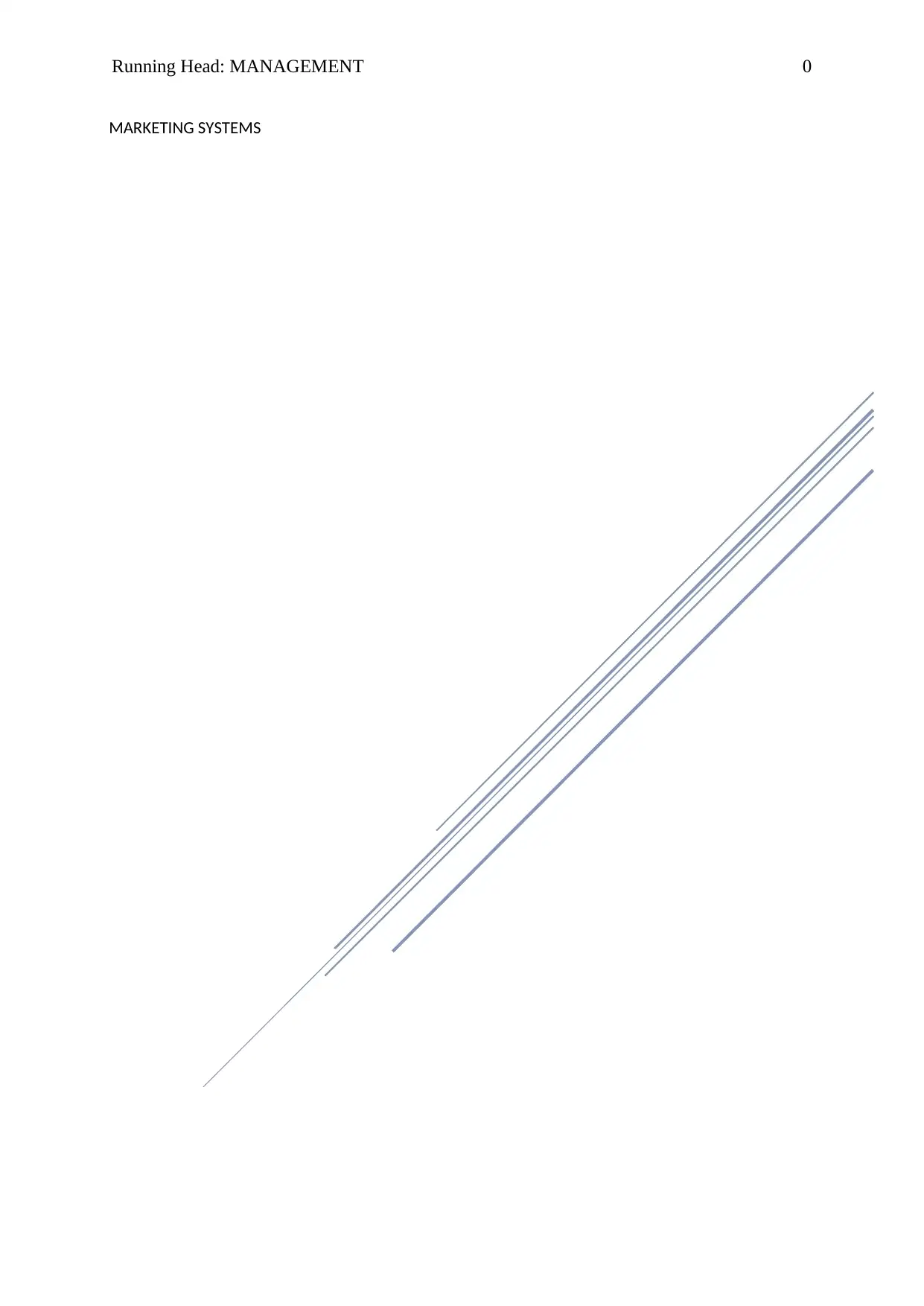
Running Head: MANAGEMENT 0
MARKETING SYSTEMS
MARKETING SYSTEMS
Paraphrase This Document
Need a fresh take? Get an instant paraphrase of this document with our AI Paraphraser
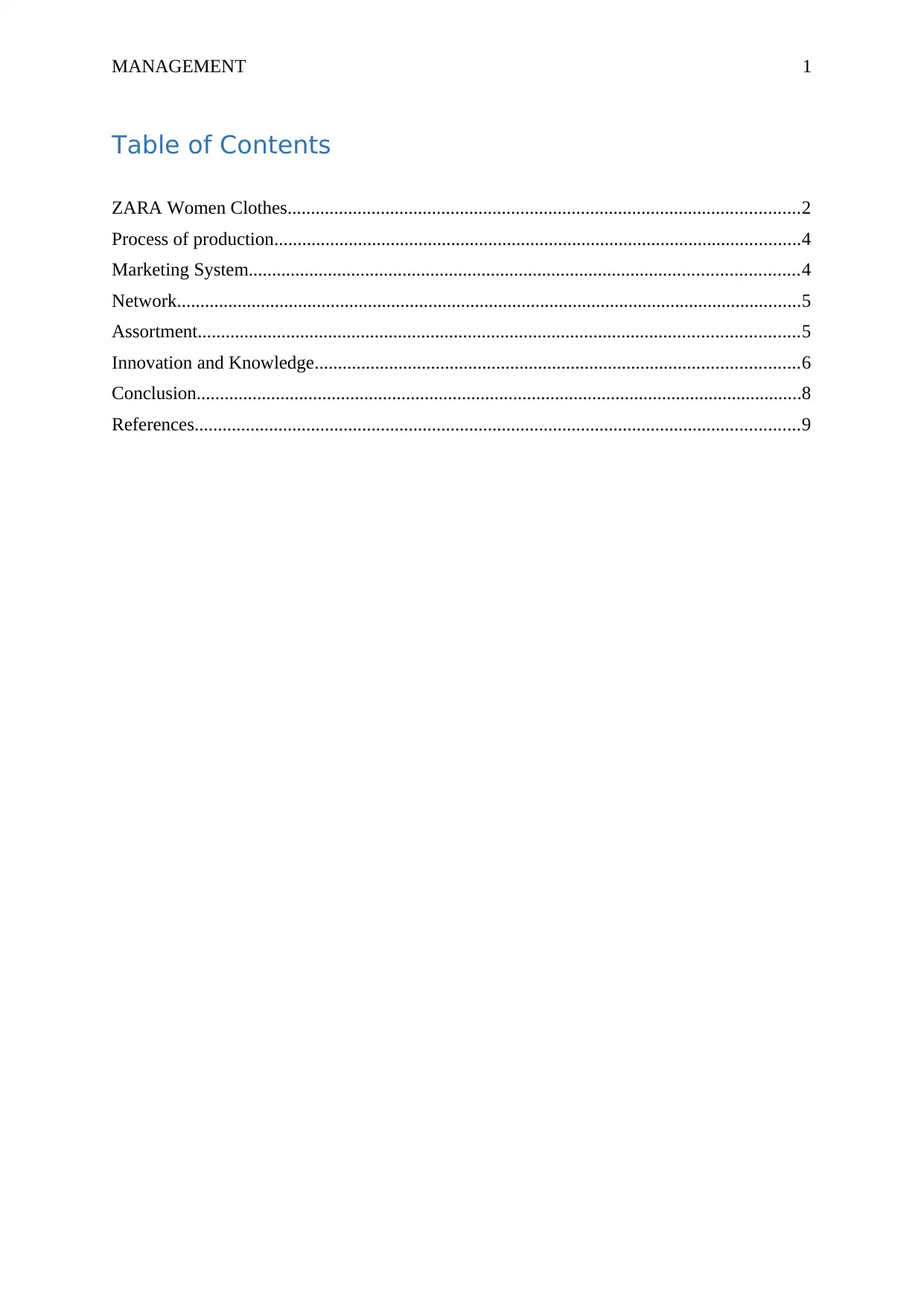
MANAGEMENT 1
Table of Contents
ZARA Women Clothes..............................................................................................................2
Process of production.................................................................................................................4
Marketing System......................................................................................................................4
Network......................................................................................................................................5
Assortment.................................................................................................................................5
Innovation and Knowledge........................................................................................................6
Conclusion..................................................................................................................................8
References..................................................................................................................................9
Table of Contents
ZARA Women Clothes..............................................................................................................2
Process of production.................................................................................................................4
Marketing System......................................................................................................................4
Network......................................................................................................................................5
Assortment.................................................................................................................................5
Innovation and Knowledge........................................................................................................6
Conclusion..................................................................................................................................8
References..................................................................................................................................9
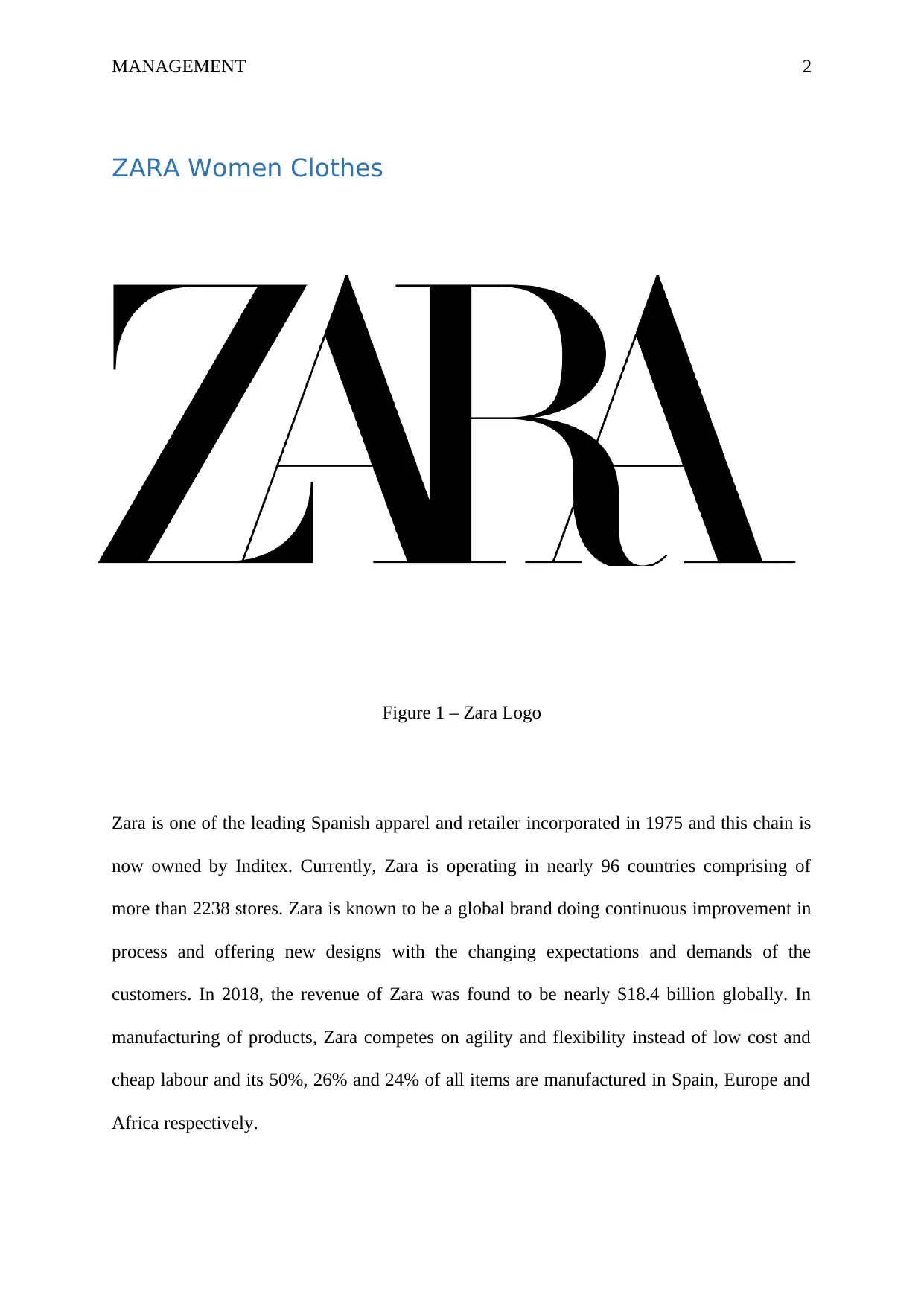
MANAGEMENT 2
ZARA Women Clothes
Figure 1 – Zara Logo
Zara is one of the leading Spanish apparel and retailer incorporated in 1975 and this chain is
now owned by Inditex. Currently, Zara is operating in nearly 96 countries comprising of
more than 2238 stores. Zara is known to be a global brand doing continuous improvement in
process and offering new designs with the changing expectations and demands of the
customers. In 2018, the revenue of Zara was found to be nearly $18.4 billion globally. In
manufacturing of products, Zara competes on agility and flexibility instead of low cost and
cheap labour and its 50%, 26% and 24% of all items are manufactured in Spain, Europe and
Africa respectively.
ZARA Women Clothes
Figure 1 – Zara Logo
Zara is one of the leading Spanish apparel and retailer incorporated in 1975 and this chain is
now owned by Inditex. Currently, Zara is operating in nearly 96 countries comprising of
more than 2238 stores. Zara is known to be a global brand doing continuous improvement in
process and offering new designs with the changing expectations and demands of the
customers. In 2018, the revenue of Zara was found to be nearly $18.4 billion globally. In
manufacturing of products, Zara competes on agility and flexibility instead of low cost and
cheap labour and its 50%, 26% and 24% of all items are manufactured in Spain, Europe and
Africa respectively.
⊘ This is a preview!⊘
Do you want full access?
Subscribe today to unlock all pages.

Trusted by 1+ million students worldwide
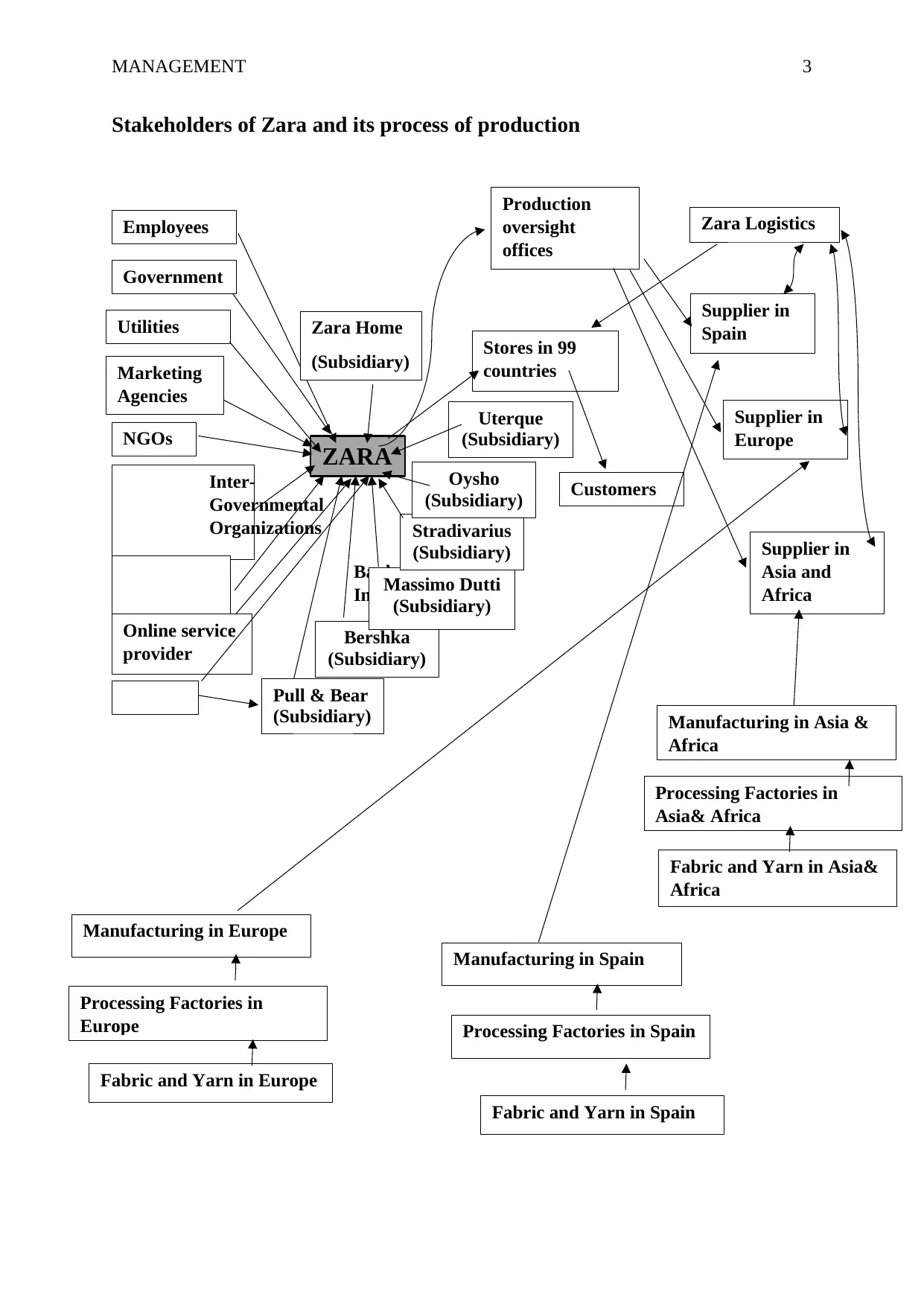
MANAGEMENT 3
Stakeholders of Zara and its process of production
d
A
Employees
Government
s
Utilities
Marketing
Agencies
NGOs
Inter-
Governmental
Organizations
Banks and
Investors
Online service
provider
Inditex
ZARA
Zara Home
(Subsidiary)
Pull & Bear
(Subsidiary)
Bershka
(Subsidiary)
Massimo Dutti
(Subsidiary)
Stradivarius
(Subsidiary)
Oysho
(Subsidiary)
Uterque
(Subsidiary)
Stores in 99
countries
Customers
Production
oversight
offices
Zara Logistics
Supplier in
Spain
Supplier in
Europe
Supplier in
Asia and
Africa
Manufacturing in Asia &
Africa
Processing Factories in
Asia& Africa
Fabric and Yarn in Asia&
Africa
Manufacturing in Europe
Processing Factories in
Europe
Fabric and Yarn in Europe
Manufacturing in Spain
Processing Factories in Spain
Fabric and Yarn in Spain
Stakeholders of Zara and its process of production
d
A
Employees
Government
s
Utilities
Marketing
Agencies
NGOs
Inter-
Governmental
Organizations
Banks and
Investors
Online service
provider
Inditex
ZARA
Zara Home
(Subsidiary)
Pull & Bear
(Subsidiary)
Bershka
(Subsidiary)
Massimo Dutti
(Subsidiary)
Stradivarius
(Subsidiary)
Oysho
(Subsidiary)
Uterque
(Subsidiary)
Stores in 99
countries
Customers
Production
oversight
offices
Zara Logistics
Supplier in
Spain
Supplier in
Europe
Supplier in
Asia and
Africa
Manufacturing in Asia &
Africa
Processing Factories in
Asia& Africa
Fabric and Yarn in Asia&
Africa
Manufacturing in Europe
Processing Factories in
Europe
Fabric and Yarn in Europe
Manufacturing in Spain
Processing Factories in Spain
Fabric and Yarn in Spain
Paraphrase This Document
Need a fresh take? Get an instant paraphrase of this document with our AI Paraphraser
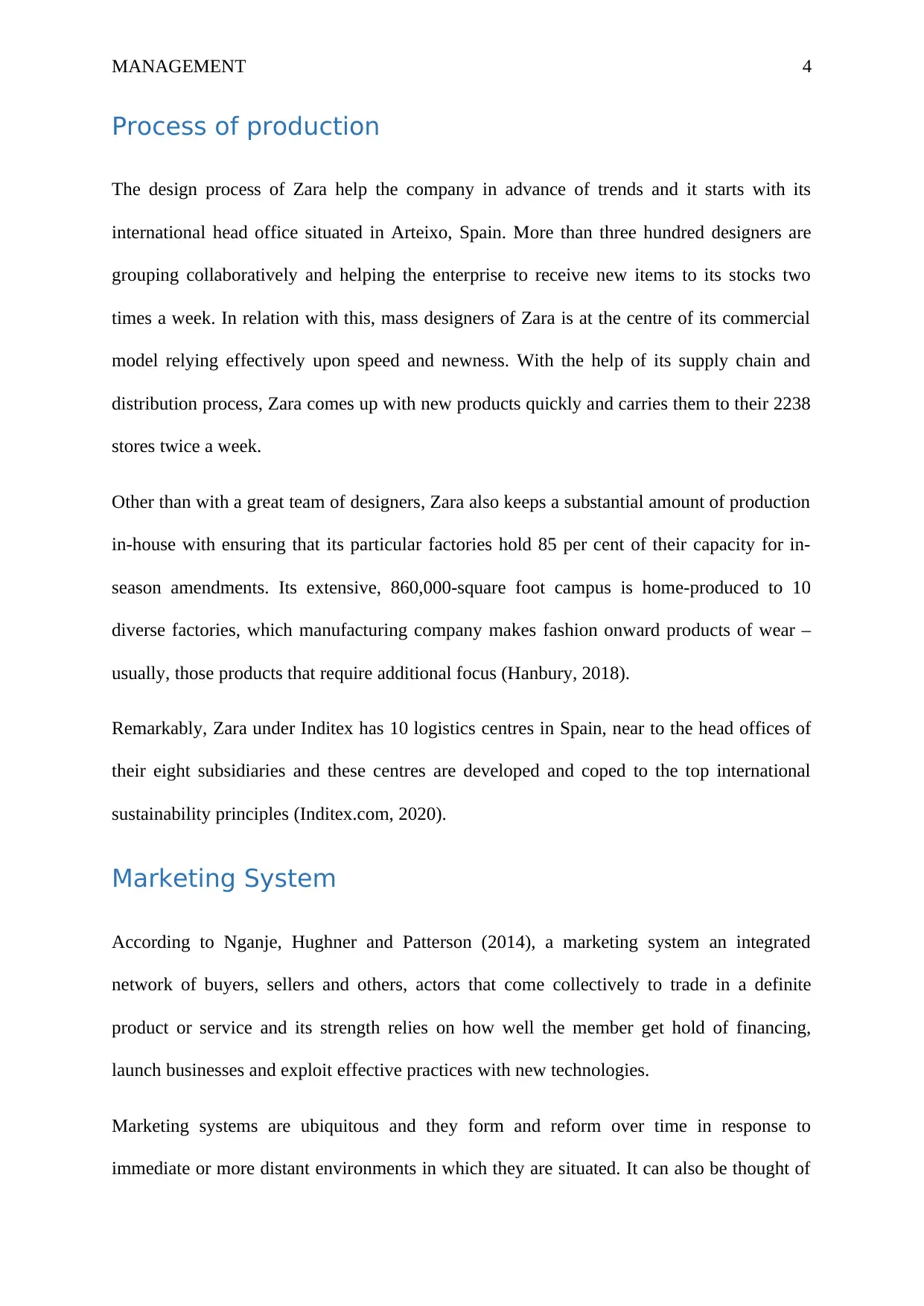
MANAGEMENT 4
Process of production
The design process of Zara help the company in advance of trends and it starts with its
international head office situated in Arteixo, Spain. More than three hundred designers are
grouping collaboratively and helping the enterprise to receive new items to its stocks two
times a week. In relation with this, mass designers of Zara is at the centre of its commercial
model relying effectively upon speed and newness. With the help of its supply chain and
distribution process, Zara comes up with new products quickly and carries them to their 2238
stores twice a week.
Other than with a great team of designers, Zara also keeps a substantial amount of production
in-house with ensuring that its particular factories hold 85 per cent of their capacity for in-
season amendments. Its extensive, 860,000-square foot campus is home-produced to 10
diverse factories, which manufacturing company makes fashion onward products of wear –
usually, those products that require additional focus (Hanbury, 2018).
Remarkably, Zara under Inditex has 10 logistics centres in Spain, near to the head offices of
their eight subsidiaries and these centres are developed and coped to the top international
sustainability principles (Inditex.com, 2020).
Marketing System
According to Nganje, Hughner and Patterson (2014), a marketing system an integrated
network of buyers, sellers and others, actors that come collectively to trade in a definite
product or service and its strength relies on how well the member get hold of financing,
launch businesses and exploit effective practices with new technologies.
Marketing systems are ubiquitous and they form and reform over time in response to
immediate or more distant environments in which they are situated. It can also be thought of
Process of production
The design process of Zara help the company in advance of trends and it starts with its
international head office situated in Arteixo, Spain. More than three hundred designers are
grouping collaboratively and helping the enterprise to receive new items to its stocks two
times a week. In relation with this, mass designers of Zara is at the centre of its commercial
model relying effectively upon speed and newness. With the help of its supply chain and
distribution process, Zara comes up with new products quickly and carries them to their 2238
stores twice a week.
Other than with a great team of designers, Zara also keeps a substantial amount of production
in-house with ensuring that its particular factories hold 85 per cent of their capacity for in-
season amendments. Its extensive, 860,000-square foot campus is home-produced to 10
diverse factories, which manufacturing company makes fashion onward products of wear –
usually, those products that require additional focus (Hanbury, 2018).
Remarkably, Zara under Inditex has 10 logistics centres in Spain, near to the head offices of
their eight subsidiaries and these centres are developed and coped to the top international
sustainability principles (Inditex.com, 2020).
Marketing System
According to Nganje, Hughner and Patterson (2014), a marketing system an integrated
network of buyers, sellers and others, actors that come collectively to trade in a definite
product or service and its strength relies on how well the member get hold of financing,
launch businesses and exploit effective practices with new technologies.
Marketing systems are ubiquitous and they form and reform over time in response to
immediate or more distant environments in which they are situated. It can also be thought of
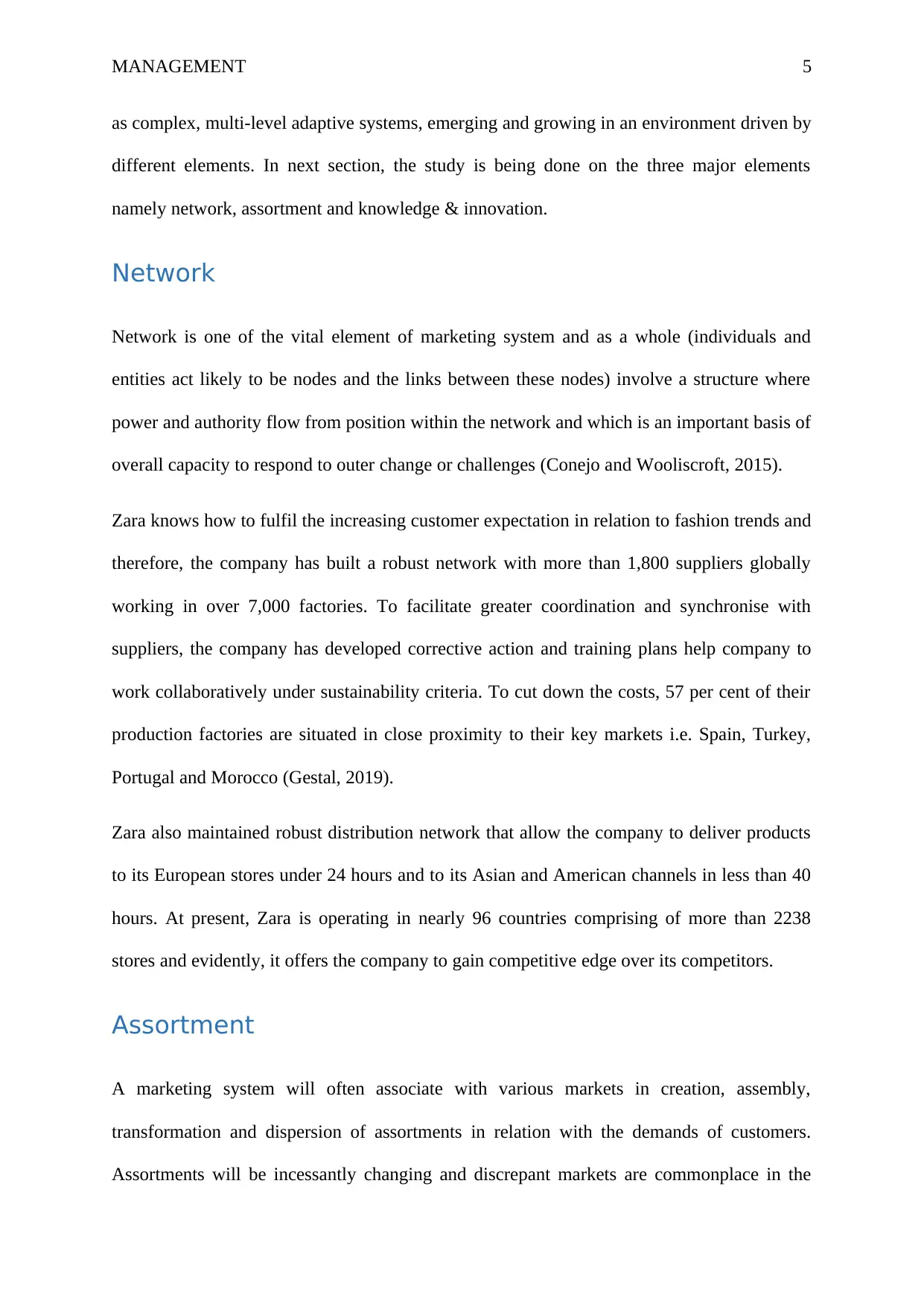
MANAGEMENT 5
as complex, multi-level adaptive systems, emerging and growing in an environment driven by
different elements. In next section, the study is being done on the three major elements
namely network, assortment and knowledge & innovation.
Network
Network is one of the vital element of marketing system and as a whole (individuals and
entities act likely to be nodes and the links between these nodes) involve a structure where
power and authority flow from position within the network and which is an important basis of
overall capacity to respond to outer change or challenges (Conejo and Wooliscroft, 2015).
Zara knows how to fulfil the increasing customer expectation in relation to fashion trends and
therefore, the company has built a robust network with more than 1,800 suppliers globally
working in over 7,000 factories. To facilitate greater coordination and synchronise with
suppliers, the company has developed corrective action and training plans help company to
work collaboratively under sustainability criteria. To cut down the costs, 57 per cent of their
production factories are situated in close proximity to their key markets i.e. Spain, Turkey,
Portugal and Morocco (Gestal, 2019).
Zara also maintained robust distribution network that allow the company to deliver products
to its European stores under 24 hours and to its Asian and American channels in less than 40
hours. At present, Zara is operating in nearly 96 countries comprising of more than 2238
stores and evidently, it offers the company to gain competitive edge over its competitors.
Assortment
A marketing system will often associate with various markets in creation, assembly,
transformation and dispersion of assortments in relation with the demands of customers.
Assortments will be incessantly changing and discrepant markets are commonplace in the
as complex, multi-level adaptive systems, emerging and growing in an environment driven by
different elements. In next section, the study is being done on the three major elements
namely network, assortment and knowledge & innovation.
Network
Network is one of the vital element of marketing system and as a whole (individuals and
entities act likely to be nodes and the links between these nodes) involve a structure where
power and authority flow from position within the network and which is an important basis of
overall capacity to respond to outer change or challenges (Conejo and Wooliscroft, 2015).
Zara knows how to fulfil the increasing customer expectation in relation to fashion trends and
therefore, the company has built a robust network with more than 1,800 suppliers globally
working in over 7,000 factories. To facilitate greater coordination and synchronise with
suppliers, the company has developed corrective action and training plans help company to
work collaboratively under sustainability criteria. To cut down the costs, 57 per cent of their
production factories are situated in close proximity to their key markets i.e. Spain, Turkey,
Portugal and Morocco (Gestal, 2019).
Zara also maintained robust distribution network that allow the company to deliver products
to its European stores under 24 hours and to its Asian and American channels in less than 40
hours. At present, Zara is operating in nearly 96 countries comprising of more than 2238
stores and evidently, it offers the company to gain competitive edge over its competitors.
Assortment
A marketing system will often associate with various markets in creation, assembly,
transformation and dispersion of assortments in relation with the demands of customers.
Assortments will be incessantly changing and discrepant markets are commonplace in the
⊘ This is a preview!⊘
Do you want full access?
Subscribe today to unlock all pages.

Trusted by 1+ million students worldwide
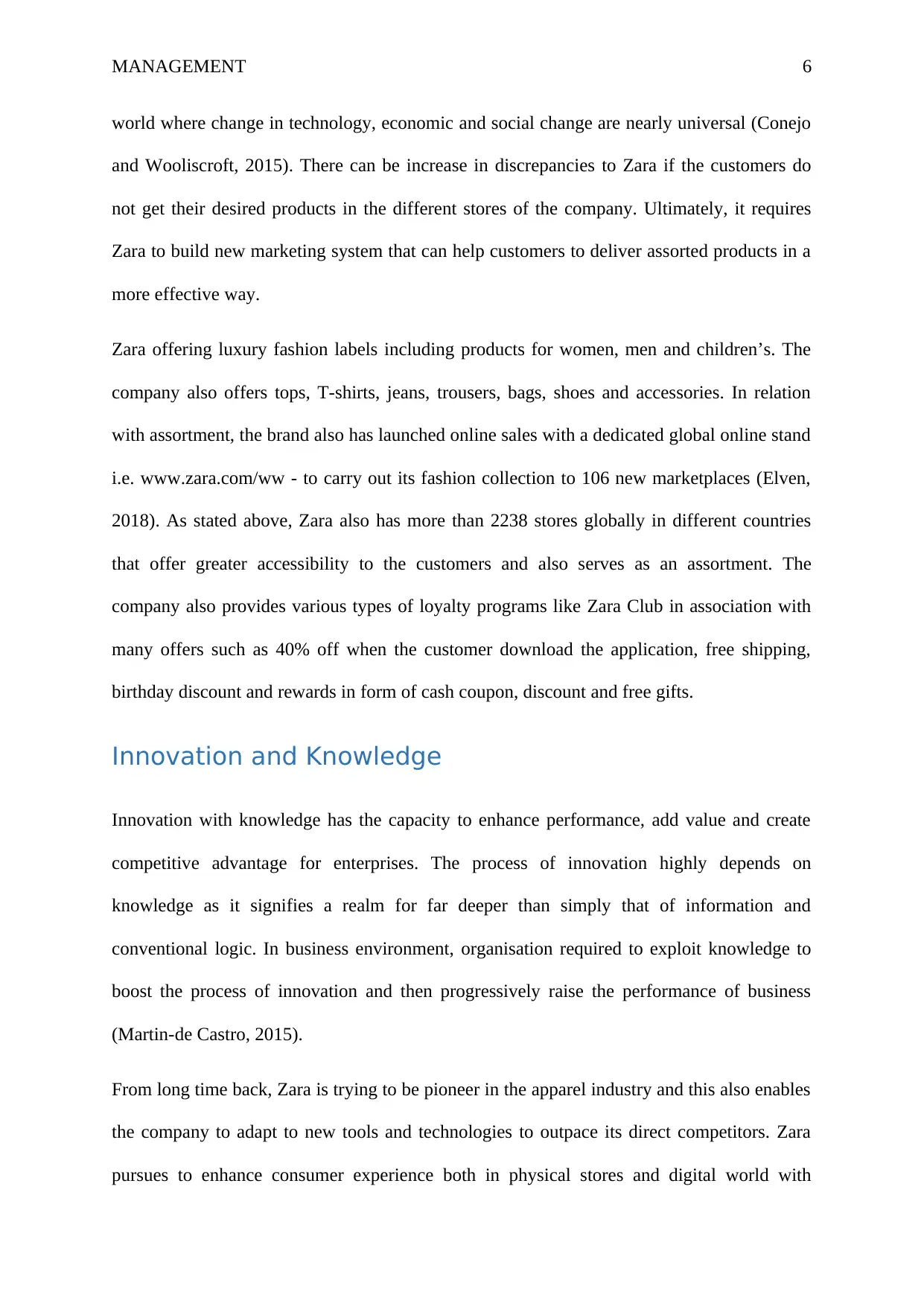
MANAGEMENT 6
world where change in technology, economic and social change are nearly universal (Conejo
and Wooliscroft, 2015). There can be increase in discrepancies to Zara if the customers do
not get their desired products in the different stores of the company. Ultimately, it requires
Zara to build new marketing system that can help customers to deliver assorted products in a
more effective way.
Zara offering luxury fashion labels including products for women, men and children’s. The
company also offers tops, T-shirts, jeans, trousers, bags, shoes and accessories. In relation
with assortment, the brand also has launched online sales with a dedicated global online stand
i.e. www.zara.com/ww - to carry out its fashion collection to 106 new marketplaces (Elven,
2018). As stated above, Zara also has more than 2238 stores globally in different countries
that offer greater accessibility to the customers and also serves as an assortment. The
company also provides various types of loyalty programs like Zara Club in association with
many offers such as 40% off when the customer download the application, free shipping,
birthday discount and rewards in form of cash coupon, discount and free gifts.
Innovation and Knowledge
Innovation with knowledge has the capacity to enhance performance, add value and create
competitive advantage for enterprises. The process of innovation highly depends on
knowledge as it signifies a realm for far deeper than simply that of information and
conventional logic. In business environment, organisation required to exploit knowledge to
boost the process of innovation and then progressively raise the performance of business
(Martin-de Castro, 2015).
From long time back, Zara is trying to be pioneer in the apparel industry and this also enables
the company to adapt to new tools and technologies to outpace its direct competitors. Zara
pursues to enhance consumer experience both in physical stores and digital world with
world where change in technology, economic and social change are nearly universal (Conejo
and Wooliscroft, 2015). There can be increase in discrepancies to Zara if the customers do
not get their desired products in the different stores of the company. Ultimately, it requires
Zara to build new marketing system that can help customers to deliver assorted products in a
more effective way.
Zara offering luxury fashion labels including products for women, men and children’s. The
company also offers tops, T-shirts, jeans, trousers, bags, shoes and accessories. In relation
with assortment, the brand also has launched online sales with a dedicated global online stand
i.e. www.zara.com/ww - to carry out its fashion collection to 106 new marketplaces (Elven,
2018). As stated above, Zara also has more than 2238 stores globally in different countries
that offer greater accessibility to the customers and also serves as an assortment. The
company also provides various types of loyalty programs like Zara Club in association with
many offers such as 40% off when the customer download the application, free shipping,
birthday discount and rewards in form of cash coupon, discount and free gifts.
Innovation and Knowledge
Innovation with knowledge has the capacity to enhance performance, add value and create
competitive advantage for enterprises. The process of innovation highly depends on
knowledge as it signifies a realm for far deeper than simply that of information and
conventional logic. In business environment, organisation required to exploit knowledge to
boost the process of innovation and then progressively raise the performance of business
(Martin-de Castro, 2015).
From long time back, Zara is trying to be pioneer in the apparel industry and this also enables
the company to adapt to new tools and technologies to outpace its direct competitors. Zara
pursues to enhance consumer experience both in physical stores and digital world with
Paraphrase This Document
Need a fresh take? Get an instant paraphrase of this document with our AI Paraphraser
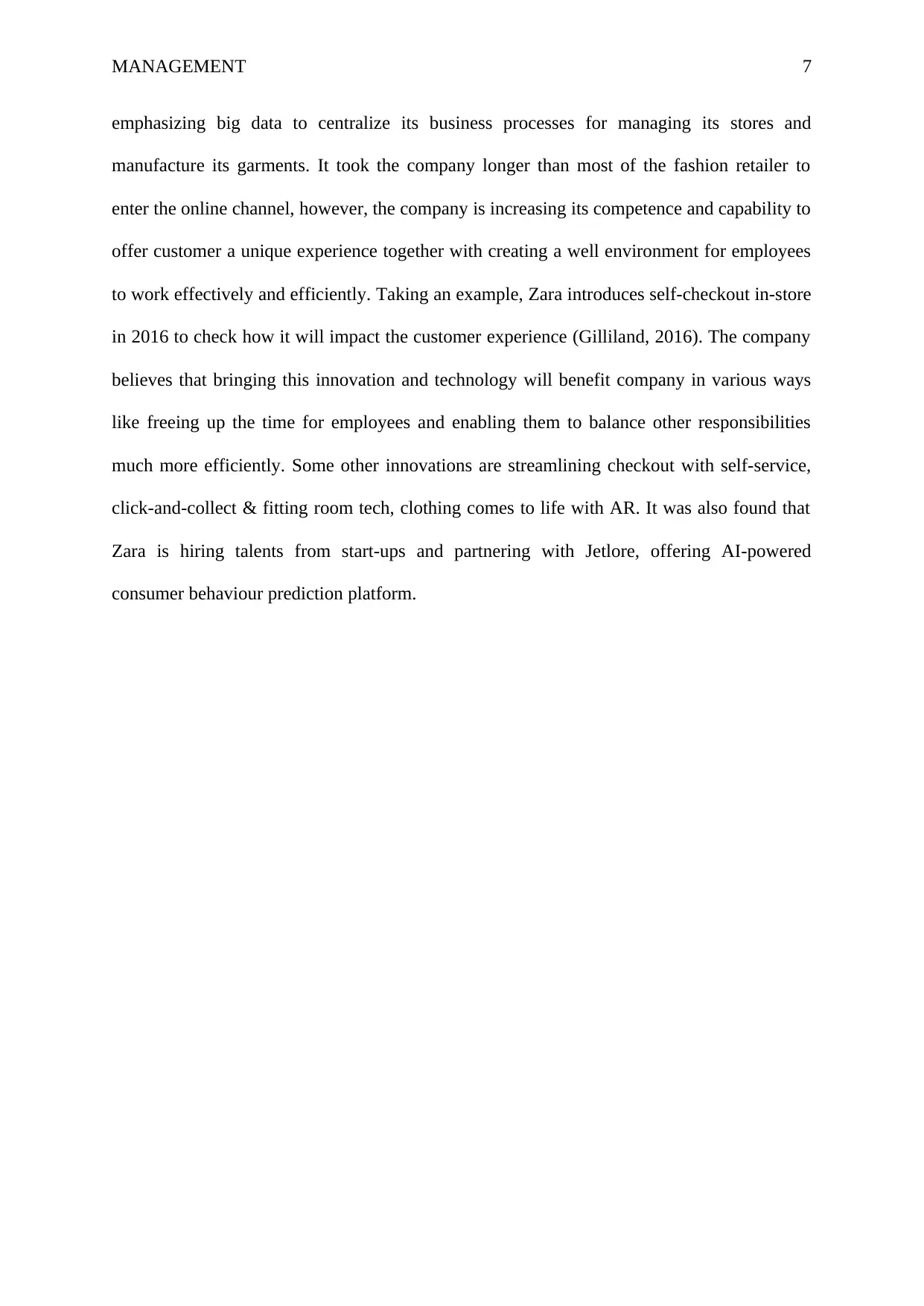
MANAGEMENT 7
emphasizing big data to centralize its business processes for managing its stores and
manufacture its garments. It took the company longer than most of the fashion retailer to
enter the online channel, however, the company is increasing its competence and capability to
offer customer a unique experience together with creating a well environment for employees
to work effectively and efficiently. Taking an example, Zara introduces self-checkout in-store
in 2016 to check how it will impact the customer experience (Gilliland, 2016). The company
believes that bringing this innovation and technology will benefit company in various ways
like freeing up the time for employees and enabling them to balance other responsibilities
much more efficiently. Some other innovations are streamlining checkout with self-service,
click-and-collect & fitting room tech, clothing comes to life with AR. It was also found that
Zara is hiring talents from start-ups and partnering with Jetlore, offering AI-powered
consumer behaviour prediction platform.
emphasizing big data to centralize its business processes for managing its stores and
manufacture its garments. It took the company longer than most of the fashion retailer to
enter the online channel, however, the company is increasing its competence and capability to
offer customer a unique experience together with creating a well environment for employees
to work effectively and efficiently. Taking an example, Zara introduces self-checkout in-store
in 2016 to check how it will impact the customer experience (Gilliland, 2016). The company
believes that bringing this innovation and technology will benefit company in various ways
like freeing up the time for employees and enabling them to balance other responsibilities
much more efficiently. Some other innovations are streamlining checkout with self-service,
click-and-collect & fitting room tech, clothing comes to life with AR. It was also found that
Zara is hiring talents from start-ups and partnering with Jetlore, offering AI-powered
consumer behaviour prediction platform.
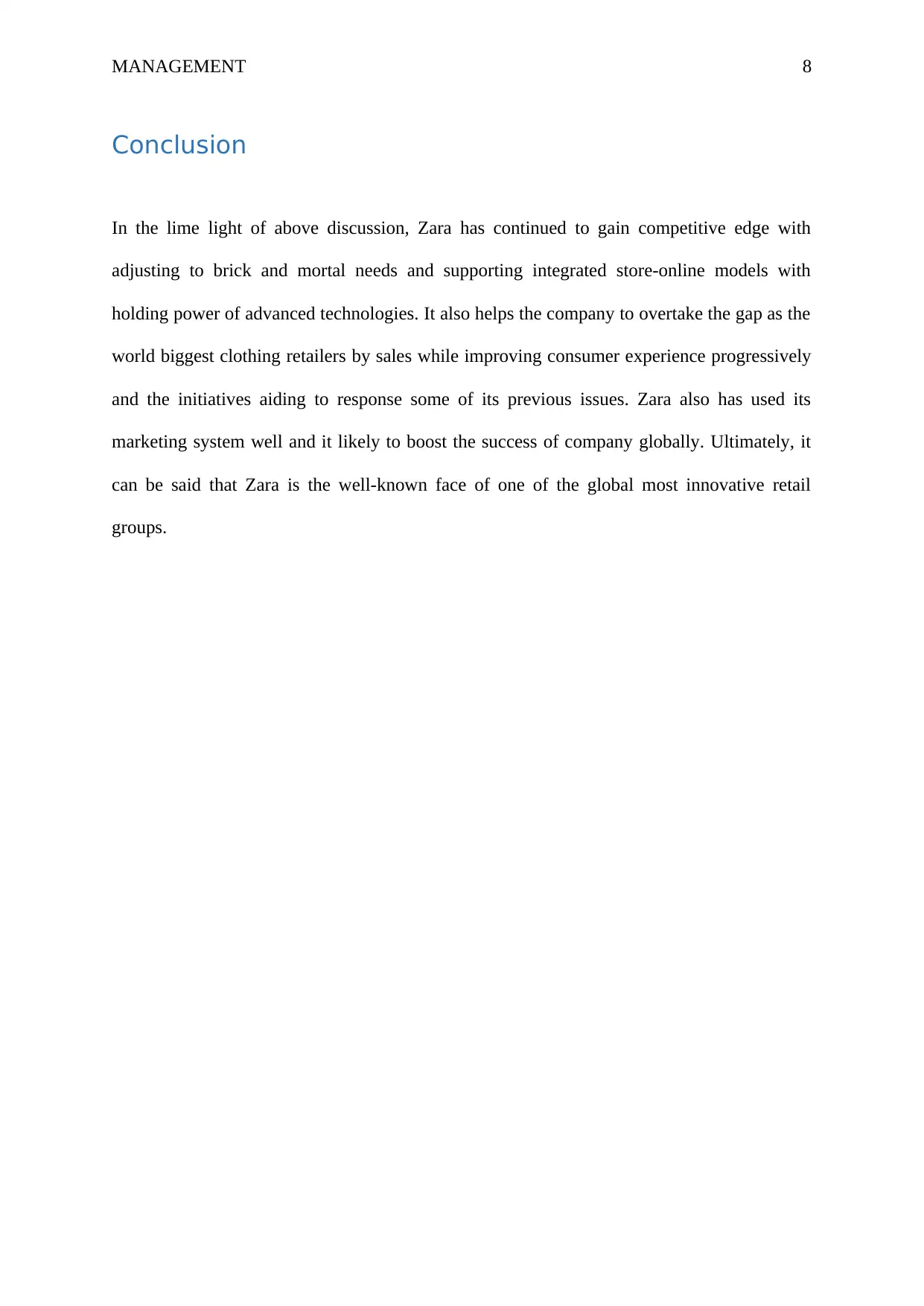
MANAGEMENT 8
Conclusion
In the lime light of above discussion, Zara has continued to gain competitive edge with
adjusting to brick and mortal needs and supporting integrated store-online models with
holding power of advanced technologies. It also helps the company to overtake the gap as the
world biggest clothing retailers by sales while improving consumer experience progressively
and the initiatives aiding to response some of its previous issues. Zara also has used its
marketing system well and it likely to boost the success of company globally. Ultimately, it
can be said that Zara is the well-known face of one of the global most innovative retail
groups.
Conclusion
In the lime light of above discussion, Zara has continued to gain competitive edge with
adjusting to brick and mortal needs and supporting integrated store-online models with
holding power of advanced technologies. It also helps the company to overtake the gap as the
world biggest clothing retailers by sales while improving consumer experience progressively
and the initiatives aiding to response some of its previous issues. Zara also has used its
marketing system well and it likely to boost the success of company globally. Ultimately, it
can be said that Zara is the well-known face of one of the global most innovative retail
groups.
⊘ This is a preview!⊘
Do you want full access?
Subscribe today to unlock all pages.

Trusted by 1+ million students worldwide
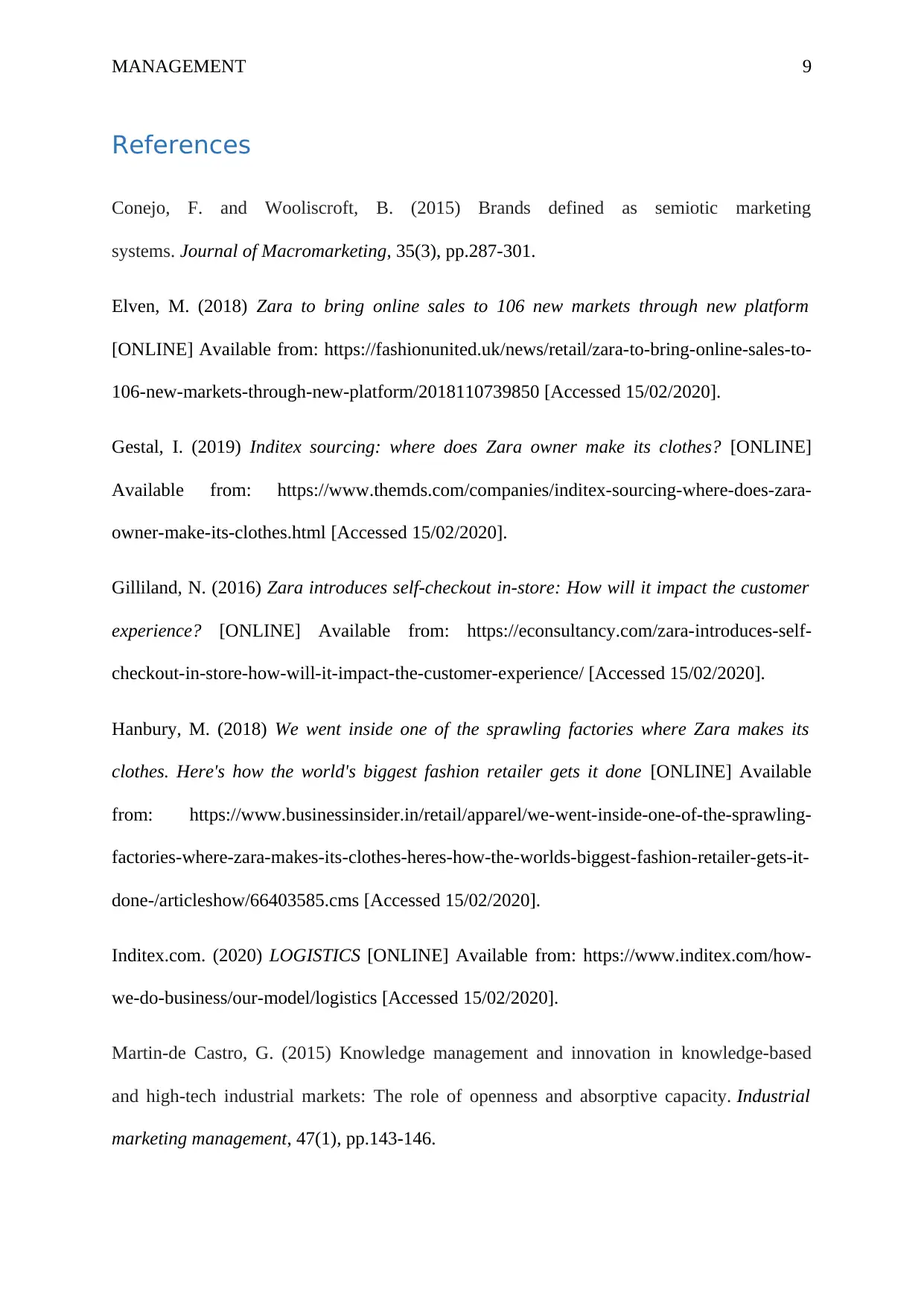
MANAGEMENT 9
References
Conejo, F. and Wooliscroft, B. (2015) Brands defined as semiotic marketing
systems. Journal of Macromarketing, 35(3), pp.287-301.
Elven, M. (2018) Zara to bring online sales to 106 new markets through new platform
[ONLINE] Available from: https://fashionunited.uk/news/retail/zara-to-bring-online-sales-to-
106-new-markets-through-new-platform/2018110739850 [Accessed 15/02/2020].
Gestal, I. (2019) Inditex sourcing: where does Zara owner make its clothes? [ONLINE]
Available from: https://www.themds.com/companies/inditex-sourcing-where-does-zara-
owner-make-its-clothes.html [Accessed 15/02/2020].
Gilliland, N. (2016) Zara introduces self-checkout in-store: How will it impact the customer
experience? [ONLINE] Available from: https://econsultancy.com/zara-introduces-self-
checkout-in-store-how-will-it-impact-the-customer-experience/ [Accessed 15/02/2020].
Hanbury, M. (2018) We went inside one of the sprawling factories where Zara makes its
clothes. Here's how the world's biggest fashion retailer gets it done [ONLINE] Available
from: https://www.businessinsider.in/retail/apparel/we-went-inside-one-of-the-sprawling-
factories-where-zara-makes-its-clothes-heres-how-the-worlds-biggest-fashion-retailer-gets-it-
done-/articleshow/66403585.cms [Accessed 15/02/2020].
Inditex.com. (2020) LOGISTICS [ONLINE] Available from: https://www.inditex.com/how-
we-do-business/our-model/logistics [Accessed 15/02/2020].
Martin-de Castro, G. (2015) Knowledge management and innovation in knowledge-based
and high-tech industrial markets: The role of openness and absorptive capacity. Industrial
marketing management, 47(1), pp.143-146.
References
Conejo, F. and Wooliscroft, B. (2015) Brands defined as semiotic marketing
systems. Journal of Macromarketing, 35(3), pp.287-301.
Elven, M. (2018) Zara to bring online sales to 106 new markets through new platform
[ONLINE] Available from: https://fashionunited.uk/news/retail/zara-to-bring-online-sales-to-
106-new-markets-through-new-platform/2018110739850 [Accessed 15/02/2020].
Gestal, I. (2019) Inditex sourcing: where does Zara owner make its clothes? [ONLINE]
Available from: https://www.themds.com/companies/inditex-sourcing-where-does-zara-
owner-make-its-clothes.html [Accessed 15/02/2020].
Gilliland, N. (2016) Zara introduces self-checkout in-store: How will it impact the customer
experience? [ONLINE] Available from: https://econsultancy.com/zara-introduces-self-
checkout-in-store-how-will-it-impact-the-customer-experience/ [Accessed 15/02/2020].
Hanbury, M. (2018) We went inside one of the sprawling factories where Zara makes its
clothes. Here's how the world's biggest fashion retailer gets it done [ONLINE] Available
from: https://www.businessinsider.in/retail/apparel/we-went-inside-one-of-the-sprawling-
factories-where-zara-makes-its-clothes-heres-how-the-worlds-biggest-fashion-retailer-gets-it-
done-/articleshow/66403585.cms [Accessed 15/02/2020].
Inditex.com. (2020) LOGISTICS [ONLINE] Available from: https://www.inditex.com/how-
we-do-business/our-model/logistics [Accessed 15/02/2020].
Martin-de Castro, G. (2015) Knowledge management and innovation in knowledge-based
and high-tech industrial markets: The role of openness and absorptive capacity. Industrial
marketing management, 47(1), pp.143-146.
Paraphrase This Document
Need a fresh take? Get an instant paraphrase of this document with our AI Paraphraser
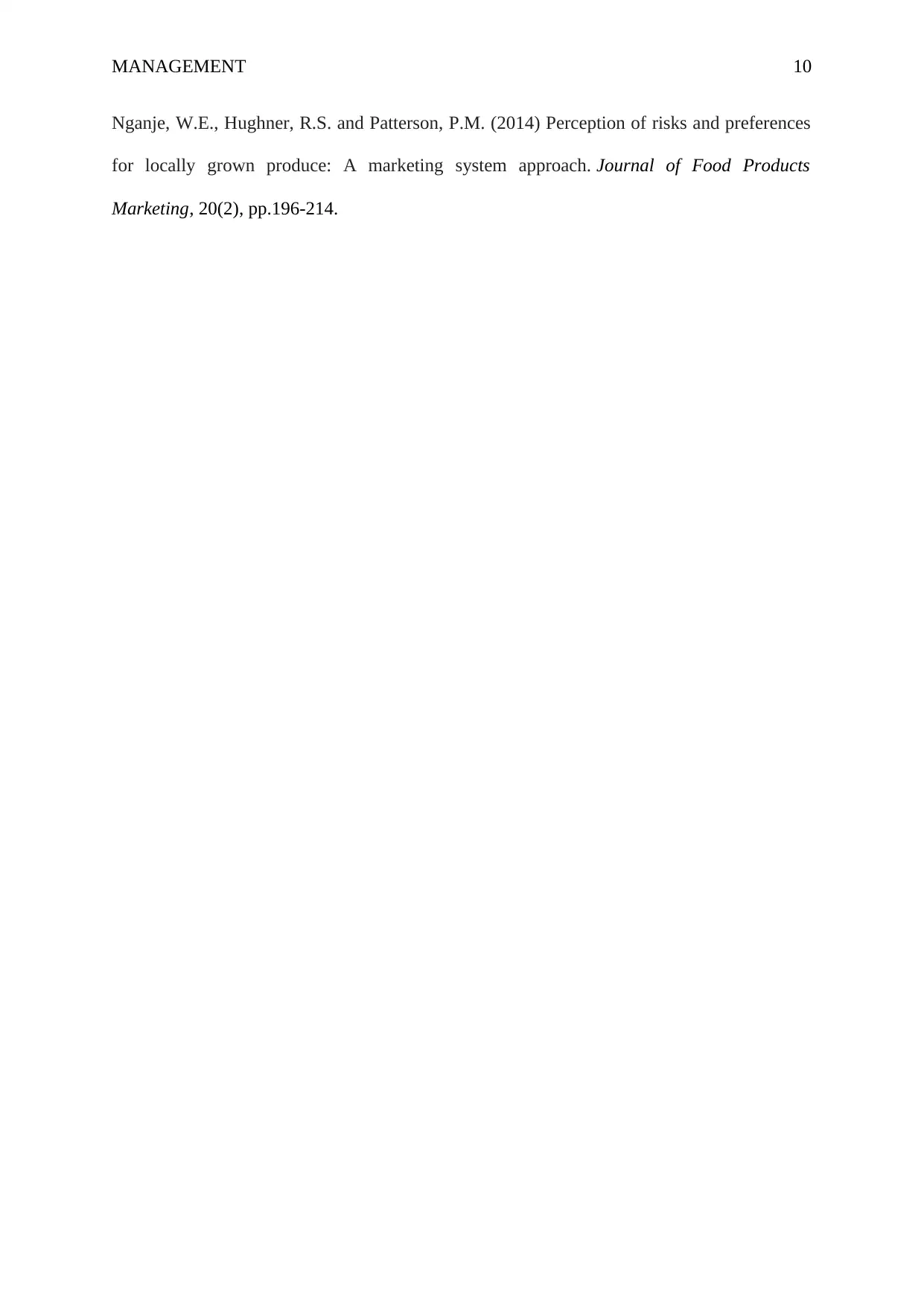
MANAGEMENT 10
Nganje, W.E., Hughner, R.S. and Patterson, P.M. (2014) Perception of risks and preferences
for locally grown produce: A marketing system approach. Journal of Food Products
Marketing, 20(2), pp.196-214.
Nganje, W.E., Hughner, R.S. and Patterson, P.M. (2014) Perception of risks and preferences
for locally grown produce: A marketing system approach. Journal of Food Products
Marketing, 20(2), pp.196-214.
1 out of 11
Related Documents
Your All-in-One AI-Powered Toolkit for Academic Success.
+13062052269
info@desklib.com
Available 24*7 on WhatsApp / Email
![[object Object]](/_next/static/media/star-bottom.7253800d.svg)
Unlock your academic potential
Copyright © 2020–2025 A2Z Services. All Rights Reserved. Developed and managed by ZUCOL.





